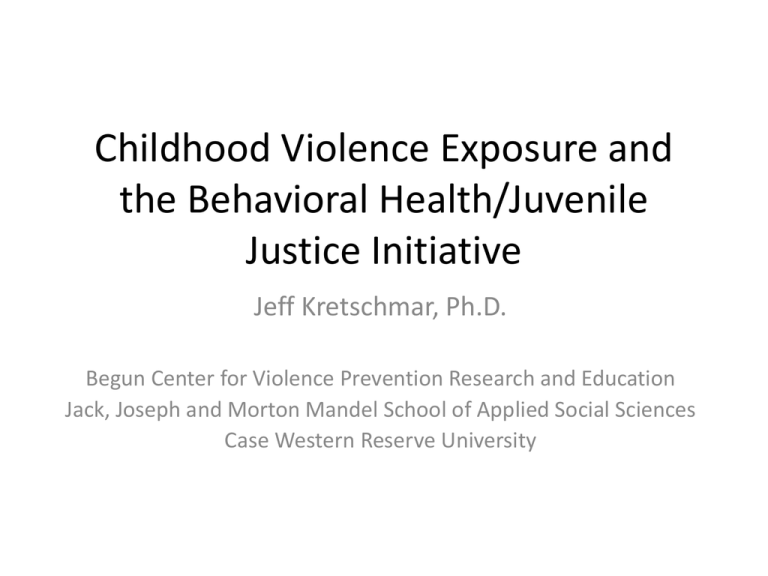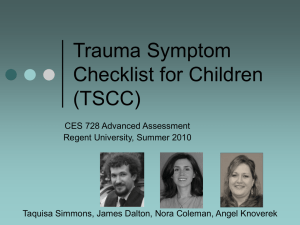The Behavioral Health/Juvenile Justice Initiative
advertisement

Childhood Violence Exposure and the Behavioral Health/Juvenile Justice Initiative Jeff Kretschmar, Ph.D. Begun Center for Violence Prevention Research and Education Jack, Joseph and Morton Mandel School of Applied Social Sciences Case Western Reserve University Acknowledgements • • • • • • • • Fred Butcher Sarah Myers Wendy Boerger Dan Flannery Mark Singer Patrick Kanary The Ohio Department of Youth Services The Ohio Department of Mental Health and Addiction Services What is BHJJ? • Diversion program for juvenile justiceinvolved youth with mental/behavioral health issues – Sponsored by the Ohio Departments of Mental Health and Addiction Services (ODMHAS) and Youth Services (ODYS) • Current goal is to reduce the number of youth with mental/behavioral health issues that are being sent to ODYS and local juvenile justice facilities. – In lieu of detention, appropriate youth are referred to the BHJJ program for evidence-based mental/behavioral health treatment. – Youth may be treated in the home, in outpatient settings, or in more intensive inpatient facilities if needed. What is BHJJ? • Participating counties must use an evidence-based treatment model, but are free to use the evidencebased treatment model that best suits the needs of the youth and families in the county. – Types of EBP’s currently used: • • • • • • Multi-systemic Therapy (MST) Functional Family Therapy (FFT) Intensive Home-Based Therapy (IHBT) Trauma-Focused Cognitive Behavioral Therapy (TF-CBT) Integrated Co-Occurring Treatment (ICT) Hi-Fidelity Wraparound Target Criteria • BHJJ targets youth: – DSM IV diagnosis – Aged 10 to 18 – Substantial mental status impairment in affective, behavioral, and/or cognitive domains – Co-occurring substance abuse – Violent and/or pattern of criminal behavior – Charged and/or adjudicated delinquent – Exposed to/victim of trauma and/or domestic violence – History of multi-system involvement BHJJ Population • Over 2,500 youth enrolled since 2006 from 11 counties – 58% male – 52% White – Average Age: 15.6 years • Average of 2.3 Axis I DSM diagnoses – ODD, Cannabis, ADHD, Depressive, Alcohol, Conduct, Bipolar, PTSD Youth and Family History Victimization 60 50 48.7 % 40 33.6 30 20 13.3 10 4.4 0 Zero (N = 1134) One (N = 783) Two (N = 310) Items Endorsed Three (N = 102) Cumulative Violence Zero One (n = 1134) (n = 783) Two or Three (n = 412) Has the child ever talked about suicide? 29% 44% 57% Has the child ever attempted suicide? 8% 17% 30% Has anyone in the child’s biological family ever been diagnosed with or shown signs of depression? 51% 70% 84% Has anyone in the child's biological family had a mental illness, other than depression? 19% 40% 49% Has the child ever lived in a household in which someone was convicted of a crime? 27% 50% 64% Has anyone in the child's biological family had a drinking or drug problem? 49% 69% 82% Cumulative Violence Zero One (n = 1134) (n = 783) Two or Three (n = 412) PTSD diagnosis 3% 7% 20% Depression diagnosis 23% 24% 26% Anxiety disorder 8% 12% 26% Parent rating of Problem Severity (Ohio Scales) 23 28 31 Youth rating of Problem severity (Ohio Scales) 19 21 24 Anxiety trauma symptoms (TSCC) 3.9 4.7 5.4 Depression trauma symptoms (TSCC) 5.3 6.2 7.2 Anger trauma symptoms (TSCC) 8.8 9.7 10.1 Treatment Impact Caregiver Ratings of Youth Problem Severity 35 30 25 Score Zero One 20 Two or Three 15 10 Intake Termination Treatment Impact Trauma Symptoms - Anxiety 6 5 Score 4 Zero 3 One Two or Three 2 1 0 Intake Termination Treatment Impact Trauma Symptoms - Depression 8 7 6 Score 5 Zero 4 One Two or Three 3 2 1 0 Intake Termination Treatment Impact Zero (n = 1134) One (n = 783) Two or Three (n = 412) Felony 12 months prior to intake 35% 31% 22% Felony 12 months after termination 19% 18% 13% Violent charge 12 months prior to intake 33% 35% 42% Violent charge 12 months after termination 20% 26% 21% Terminated treatment successfully 69% 64% 64% Exposure during treatment • Measured self-reported violence exposure (witness or victim) at home, school, and in the community at intake and termination using the 26-item Recent Exposure to Violence Scale (Singer, et al., 1995) (0-78 scale). • Examined the impact of violence exposure during treatment on trauma symptoms (TSCC) at termination. Exposure during treatment • Linear regression controlling for gender, race, age, TSCC subscale score at intake, and exposure at intake and termination • For all six subscales (Anger, Anxiety, Depression, Dissociation, PTSD, Sexual Concerns), an increase in exposure during treatment led to significant increases in trauma scores from intake to termination. Exposure during treatment TSSC Subscale Increase as Exposure Scores Increase by One Point 0.35 0.31 TSCC Score increase 0.3 0.25 0.23 0.2 0.24 0.18 0.17 0.16 0.15 0.1 0.05 0 Anger Anxiety Depression Dissociation PTSD Sexual Concerns Summary • While cumulative exposure has significant impacts on youth, evidence-based treatment can be effective • Upon completion of treatment, youth with multiple exposures can look similar to other youth on trauma symptoms and functioning. • Violence exposure during treatment has a negative impact on trauma symptoms







